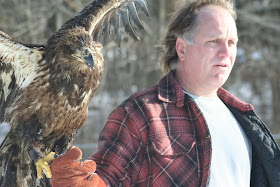
Photograph by Sally of the Tulsa Hawk Forum
These photos are important further down.

Photograph by Sally of the Tulsa Hawk Forum
London Plane Fruit, naturally dried

Jackie of the Tulsa Hawk Forum has done some sleuthing about the materials in the Tulsa nest--
Hi, Donna:
I will put your query as to the potential sappiness and/or fragrance of sycamore pods to the Forumers. I do not have an answer without researching it. And maybe then, there is no information on the Web. Who knows?
I can say that the pods have not supplanted the use of evergreen boughs. We have photos showing pine or some such evergreen in the nest (both this year and last). AND, this year we have just detected a pussywillow branch! Talk about soft--I'd be plucking the catkins, were I a hawk, and lining my nest with those beauties. :)
I'm attaching a few photos of nest materials we've seen so far this season.
1. 2. pussywillows
3.fluff and feathers
4. JAY bringing sycamore fruits to the nest!
5. Jay in a sycamore tree
6. misc. nest materials
7. pussy willows circled in the foreground; and see evergreen in the back
All photos from KJRH Hawk Cam, except the two of Jay, which are by Russell Mills of KJRH.
Jackie (Tulsa Hawk Forum)

Pussy Willow twigs

The fluff, the way the seeds of London Plane distribute themselves to a larger area, that extrudes from the dried fruit.
As if you don't have anything else to think about, here's a question.
I was wondering if you might know of any medicinal value of the plane tree bark or fruits that might make it useful for the RT's to take to their nests? I have been trying this morning to research this but found very little, except to have mistakenly read about the anti-parasitic properties of the Egyptian sycamore fig tree, a ficus I find out, not related to our sycamore platanus family. With your interest in the medieval arts and pennsic war I thought you might have some unique references to call upon! According to Wiki the Roman Pliny the Elder documented medicinal uses of the plane in
Naturalis Historia
http://en.wikipedia.org/wiki/Platanus_orientalis
Naturalis Historia (Latin for "Natural History") is an encyclopedia written circa AD 77 by Pliny the Elder.
I am going out today and if I see any wayward sycamore branches with pods that have fallen in our recent ice storm I will pick them up for touching and feeling
Sally
And here are my gleanings--
Platanus x acerifolia., is the scientific name for the hybridized tree found on city streets. Below are folk uses for the indigenous species.
The sugary sap has been tapped from the occidental plane and used for human consumption in North America.
A number of medicinal uses are known in folk medicine for the plane trees. These include some medicinal preparations made from the leaves and the bark of the oriental plane. A range of external and internal medicinal uses have been described for preparations made from the bark of the occidental plane.
Dyes have been prepared from the roots and stems in Kashmir.
In the Far East it is believed that Plane fruit has an insecticidal quality that restrains Plane lice—a group of insects that frequent plants. (Wood is from a plant and nests are made of wood.)
I found only one reference to this belief, nor could I find any information as to whether anyone had tested it to see if it were true.
I did find an extract that posited that tetramic acid derivatives controlled insects from the genus of the plane lice. (sternorrhyncha)
A stretch but here’s a hypothesis that could be tested as a possible reason (if there is one) for the stashing of Plane fruit in nests. The plane fruit has a high tetramic acid content (or other insecticidal quality) which might help keep wood loving insects under some control.
And Sally's secondary report--
(Her photos head today's post)
I did go out and get some sycamore fruit pods, they are dry and rough, and several were beginning to open to reveal their tiny golden brown hairlike seed pods,covered in pollen or some kind of dust. It reminded me of shorter little dandelion puffs. Inside those there is another round hard thing that the hairy achene attach to, like an actual seed perhaps. There is an order to the pods, perhaps a bit bitter sweet but not like a pine scent nor like a grass scent, and no sap or substance other than the powdery stuff in the fluffs.

More of Bobby Horvath and creance flying of the young Bald Eagle that had been saturated in mystery gunk that ruined her feathers.




































